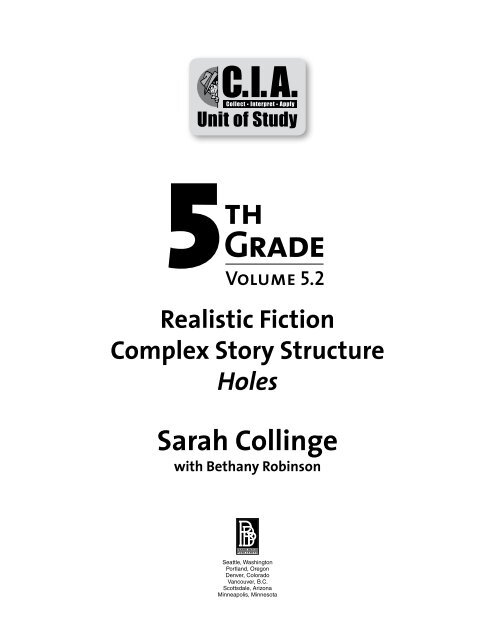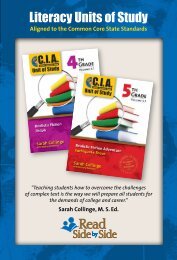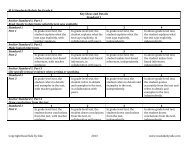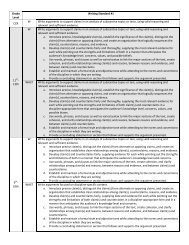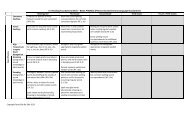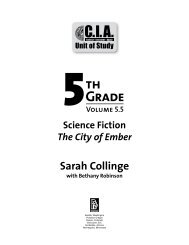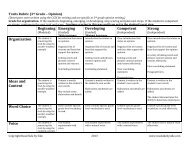Look Inside - Read Side By Side
Look Inside - Read Side By Side
Look Inside - Read Side By Side
Create successful ePaper yourself
Turn your PDF publications into a flip-book with our unique Google optimized e-Paper software.
Copyright © 2012 by <strong>Read</strong> <strong>Side</strong> by <strong>Side</strong>ISBN: 978-1-59849-128-9Library of Congress Control Number: 2012930677Printed in the United States of AmericaDesign: Soundview Design StudioAll rights reserved. No part of this book may be transmitted in any formor by any means, electronic or mechanical, including photocopying,recording, or by any information storage or retrieval system, in part,in any form, without the permission of the author.Requests for such permissions should be addressed to:Peanut Butter Publishing2925 Fairview Avenue EastSeattle, Washington 98102877-728-8837www.peanutbutterpublishing.com
Table of ContentsWelcome to the C. I. A. Unit of Study, Holes......................................................................................5Get to Know the C. I. A. Approach....................................................................................................8Visualize the Year.............................................................................................................................10Set Up for Success............................................................................................................................11Prepare a Teacher’s Guide...........................................................................................................11Designate a Daily <strong>Read</strong>-Aloud Block..........................................................................................13Prepare a Meeting Area...............................................................................................................14Get <strong>Read</strong>y for Turn and Talk......................................................................................................15Prepare <strong>Read</strong>er’s Notebooks........................................................................................................17Get <strong>Read</strong>y for Vocabulary Instruction........................................................................................17Locate Multiple Copies of the Text.............................................................................................19Input Daily Lessons Into Your Plan Book...................................................................................19Prepare for Assessment...............................................................................................................19Alignment to the Common Core State Standards.............................................................................21Holes Unit of Study—Distribution of Standards.........................................................................22Holes Text Complexity................................................................................................................27Holes Scope and Sequence................................................................................................................28Holes Stems List................................................................................................................................34Suggestions for Supporting Guided Practice.....................................................................................37C. I. A. Lesson Plans: Holes..............................................................................................................39Collect Critical Information.............................................................................................................41Day 1 – Blurb............................................................................................................................42Day 1 – Mark Each Quadrant of the Text..................................................................................46Day 2 – Genre............................................................................................................................48Day 3 – Author’s Craft...............................................................................................................51Day 4 – Setting Map..................................................................................................................54Day 5 – Family Tree...................................................................................................................58Day 6 – Characters’ Circumstances (Setting)..............................................................................63Day 7 – Outside Text: Juvenile Boot Camps..............................................................................66Day 8 – Problem/Solution/Opinion Writing..............................................................................70Day 9 – Character List...............................................................................................................74Day 10 – Important Events........................................................................................................80Day 11 – Retell Summary Writing.............................................................................................84Holes Unit of Study 3
Interpret the Text (1)........................................................................................................................87Day 12 – Infer Character Traits..................................................................................................88Day 13 – Identify an Additional Plot.........................................................................................91Day 14 – Problem/Solution/Results Writing..............................................................................96Day 15 – Metaphor....................................................................................................................99Day 16 – Parallel Plot and Prediction.......................................................................................101Day 17 – Infer Character Traits................................................................................................105Day 18 – Infer Author’s Perspective..........................................................................................109Day 19 – Characters Change Over Time..................................................................................113Day 20 – Revise Visualizations.................................................................................................117Day 21 – Use Foreshadowing to Make Predictions...................................................................122Day 22 – Characters Change Over Time..................................................................................125Day 23 – Make Predictions......................................................................................................129Day 24 – Characters Change Over Time..................................................................................132Day 25 – Identify an Additional Plot.......................................................................................136Day 26 – Line of Thinking.......................................................................................................141Interpret the Text (2)......................................................................................................................147Day 27 – Infer Connections Across Plots.................................................................................148Day 28 – Outside Text: Belle Starr—the Bandit Queen............................................................152Day 29 – Comparison Writing.................................................................................................159Day 30 – Author’s Craft: Mood................................................................................................162Day 31 – Characters Change Over Time..................................................................................166Day 32 – Sympathy/Empathy..................................................................................................170Day 33 – Revise a Prediction....................................................................................................173Day 34 – Collect Evidence.......................................................................................................177Day 35 – Turning Point...........................................................................................................181Day 36 – Turning Point Writing..............................................................................................185Apply to Your Life..........................................................................................................................189Day 37 – Predict......................................................................................................................190Day 38 – <strong>Read</strong>-In.....................................................................................................................194Day 39 – Analyze and Reflect on Lyrics....................................................................................196Days 40 – 45 Formal Writing: Letter to an Author...................................................................202References......................................................................................................................................207Vocabulary Handbook...................................................................................................................209Holes Highlighting Directions and Labels for the Instructor’s Book................................................2364 Holes Unit of Study
Welcome to the C. I. A. Unit of Study for the book HolesThis unit of study was put together for the purpose of teaching students how to read longer, morecomplex text. Unfortunately, in classrooms where only basal readers are used, many students donot learn how to make the transition from picture books, to series books, to more complex chapterbooks. As a result, students struggle during independent reading. This unit of study will teach studentsthe fundamental processes of reading text, specifically longer, more complex chapter books. Itfollows an approach described in its companion text, Raising the Standards through Chapter Books:The C. I. A. Approach. I hope you enjoy guiding your students through the authentic work of expertreaders!Holes, by Louis Sachar, is one of my all-time favorite books, and I have used it as a read-aloudin my classroom for years. It just gets better every time! The book connects well to the first unit inthe C. I. A. series for fifth grade, Earthquake Terror, because it continues to explore the genre realisticfiction. Students continue to learn that when reading realistic fiction it is important to focus onthe main character in order to determine the author’s message. In classrooms where the EarthquakeTerror unit was taught, students will recognize that, like Jonathan, Stanley has to change in order tosurvive harsh conditions.Holes was intentionally chosen as a read-aloud text for fifth grade because of its complex storystructure. Students who participated in the Earthquake Terror unit of study will build on theirknowledge of complex story structure as they read Holes. Throughout the book, Louis Sachar weavestogether five separate plots:1. Stanley’s story at Camp Green Lake (present)2. Stanley’s story of how he came to Camp Green Lake (past)3. The story of Stanley’s great-great-grandfather, Elya Yelnats4. The story of Stanley’s great-grandfather, Stanley Yelnats5. The story of Kissin’ Kate BarlowStudents will use small sticky note flags to mark Stanley’s Camp Green Lake story, Elya Yelnats’sstory, and Kissin’ Kate Barlow’s story.Throughout the lessons, students will analyze the connections across the various plots. They willlearn that a parallel plot is one that is completely separate from but informs another plot. The storyof Elya Yelnats will be mirrored in Stanley’s plot. Elya became physically stronger and more confidentjust as Stanley became physically stronger and more confident. Elya learned a lesson—that wecan choose our destiny. Stanley eventually learns this same lesson.The complexity of the text is also increased by the author’s artful use of dark humor to conveyseveral messages. Louis Sachar effectively uses sarcasm and irony in his portrayal of Camp GreenLake and its characters, and he addresses difficult topics in a humorous way that makes themapproachable.Key messages in this book:• We have the power to control our destiny.• Juvenile boot camps are ineffective.• We are cursed by stereotypes, if we choose to let them define us.Holes Unit of Study 5
Difficult topics:• Crime• Discipline• Bullying• Obesity• Homelessness• Poverty• Racism• Stereotypes• GreedThe way you read the book will communicate the author’s message. I have a few suggestions forhow to read dialogue for these characters:Mr. Sir – read with a sarcastic toneMr. Pendanski – read with a “motherly,” condescending voiceThe Warden – exaggerate her accent, slow her dialogue down, make it clear that she is in control(feared)All the boys – read as tough on the outside, but still kids with normal kid feelingsIn terms of intertextuality, there is a loose reference to the story of Moses in the book Holes.• The Israelites were a nation of doubting people just as Stanley’s family is one of doubtingpeople.• God cursed the Israelites to wander the desert for 40 years, in order to bring forth a newgeneration. Stanley is the “new generation” of the Yelnats family, which was cursed inthe past.• God signaled his presence to the Israelites in many ways, including by giving them a miraculoussupply of manna. God signaled his presence to Stanley at God’s Thumb when hesupplied Stanley with a miraculous supply of water and onions.• Moses proves he is heroic by overcoming his doubts, timidity, and inner strife. Stanleydemonstrates the same heroic qualities as he changes throughout the story.Because of the multiple plots, students will have to monitor their comprehension of each one.Students will keep an important events list describing how Stanley came to Camp Green Lake,and they will summarize that plot at the end of the first quadrant. Students will keep track ofimportant events when reading Elya’s story and will write a problem/solution/results paragraphbased on those events. Students will again keep track of story elements when they read KatherineBarlow’s story.Throughout this unit it, will be really important to keep charts easy to read, colorful, and displayedon the classroom wall, as they will be used often for referencing and for monitoring comprehension.Students will use the charts to keep track of all the characters and plots.I know you will love reading Holes with your students! The book is fun and engaging and willget students, especially your boys, excited about reading.Before starting this unit of study with your students, you will want to read and label a copy ofthe book Holes, to be used as a teacher guide. You will also want to acquire a class set of books forstudents to use during read-aloud. Take time to get to know the scope and sequence, and input lessonsinto your plan book ahead of time.6 Holes Unit of Study
At the back of this unit you will find a vocabulary handbook. Please print a copy of this handbookfor each student. It will be used almost daily and is an essential component of this unit of study.If this is your first time teaching a C. I. A. unit, you will want to first familiarize yourself with theC. I. A. approach. You will then need to lay the groundwork for optimizing your success with thisunit in your classroom by:• Designating a read-aloud block in your daily schedule• Setting up a meeting area• Planning for turn and talk• Preparing reader’s notebooks• Preparing for assessmentHoles Unit of Study 7
Alignment to the Common Core State StandardsAll lessons in this unit of study are aligned to our nation’s Common Core State Standards (CommonCore State Standards Initiative [CCSSI], 2010). At the beginning of each lesson, you will see an outlineof the learning targets for that particular day. The following abbreviations are used to link thesetargets to the Common Core State Standards:RLRIWSLL<strong>Read</strong>ing Standards for Literature<strong>Read</strong>ing Standards for Informational TextWriting StandardsSpeaking and Listening StandardsLanguage StandardsC. I. A. units do not comprise a comprehensive curriculum. Rather, the units provide modelingand guided practice in on- or above-grade-level texts. Therefore, the units cover standards in readingcomprehension, writing, speaking, listening, and vocabulary. C. I. A. units of study supplement curriculumfor teaching phonics and fluency.To download a copy of the Common Core State Standards, visit http://www.corestandards.org/the-standards.Holes Unit of Study 21
Holes Unit of Study—Distribution of Standards22 Holes Unit of Study
Holes Unit of Study 23
24 Holes Unit of Study
Holes Unit of Study 25
26 Holes Unit of Study
Holes Text ComplexityQualitative MeasuresLevels of MeaningMultiple themes throughout the book increase the challenge forreaders of this text. Themes include but are not limited to fateand destiny, redemption, and right vs. wrong. These themes areconveyed through the author’s use of dark humor. Louis Sacharuses sarcasm to raise difficult topics such as crime, discipline,obesity, poverty, homelessness, racism, stereotypes, greed, andbullying in a humorous way.StructureThis narrative is told by means of an unconventional andcomplex story structure. Students must navigate five plot lines,revealed through flashbacks:1. Stanley’s story at Camp Green Lake (present)2. Stanley’s story of how he came to Camp Green Lake (past)3. The story of Stanley’s great-great-grandfather, Elya Yelnats4. The story of Stanley’s great-grandfather5. The story of Kissin’ Kate BarlowQuantitative MeasuresThe Lexile level for Holes is 660,based on word frequency andsentence length. This is in the midtoupper range of the complexityband for 2 nd –3 rd grade according tothe Common Core State Standards.<strong>Read</strong>er TaskConsiderationsThese should be determined locallywith reference to motivation,knowledge, and experiences as wellas to the purpose and complexity ofthe tasks assigned and the questionsposed.Sachar also uses the parallel plots of Elya and Stanley in a waythat allows students to recognize foreshadowing across plots.Language Conventionality and ClarityLouis Sachar uses figurative and ambiguous language and humorthroughout the text, including sarcasm and irony. Historical languageand dialect add a greater depth to the language of this text.Knowledge DemandsWhile reading, students will need to rely on their understandingof the setting of the story to keep track of shifting time periods.In addition, there is a loose reference to the story of Moses inthe book Holes. Key details from the story of Moses that parallelthose in Stanley’s story include:• The Israelites were a nation of doubting people• God cursed the Israelites to wander the desert for 40years in order to bring forth a new generation• God signaled his presence in many ways, including bygiving the Israelites a miraculous supply of manna• Moses proved himself heroic by overcoming his doubts,timidity and inner strifeHoles Unit of Study 27
Day 5, Family Tree—Chapter 3, pP. 6–10Mini-LessonVocabulary Routine: perseverance (L 4, 5)The base word ‘severe’ means difficult to endure. The prefix ‘per’ means through or by meansof. The suffix ‘ance’ makes this word a noun.Instructional <strong>Read</strong>-AloudIn this chapter…Stanley is on the bus to Camp Green Lake. He thinks about how unlucky he is,probably because of his no-good-dirty-rotten-pig-stealing-great-great-grandfather. The reader learnsthat the grandfather had a curse put on him by a one-legged gypsy. Every Stanley Yelnats, fromthis Stanley’s great-grandfather to his father, has had bad luck. Kissin’ Kate Barlow robbed Stanley’sgreat-grandfather, and his Dad is an unsuccessful inventor. Stanley realizes he too is cursed.In this lesson…you will be modeling how good readers keep track of important characters whilereading. One way in which readers keep track of important characters within a family is by makinga family tree. A family tree helps readers understand the relationship between characters, both livingand dead.Learning Targets:<strong>Read</strong> closely to monitor comprehension (RL 1)• Determine importance• InferAnalyze story elements (RL 3)• CharacterGather and categorize information through note taking (W 8)Convey ideas precisely using appropriate vocabulary (L 3, 6)Engage in collaborative discussion (SL 1, 2, 4, 6)Connect:We have been learning……that good readers pay close attention to the setting at the beginning of the story in order tounderstand the story better.58 Holes Unit of Study
Teach:Today I am going to teach you……that good readers read to determine who the important characters in the book are, and infercharacter traits. Today we will be introduced to Stanley’s relatives, both living and dead. We willbe thinking about the relationship between these family members.Watch me as I model how I look for clues that reveal which are the most important characters inthe text.Notice how I consider what I know about each character and how the characters are related toone another.Today we will be using this stem for turn and talk:When the book said _____, I was thinking this was an important detail because _____.Open up your reader’s notebooks to a clean page, and title the page Stanley’s Family Tree. Nowdraw the outline of a tree so that it fills the whole page. This is where we will keep track of charactersin Stanley’s family tree.Begin reading chapter 3 of Holes, starting on page 6.Model:Stop after: “Stanley was arrested later that day.” (p. 7)Stanley is definitely an important character in our book—he is the main character. We are goingto write Stanley’s name at the bottom of our tree, since he is the youngest generation.Listen as I recall details about Stanley.When the book said Stanley was overweight and was humiliated by students and teachers at hisschool, I was thinking this was an important detail because Stanley is bullied and doesn’t haveany friends. This shows he probably has low self-esteem.(Model adding information about Stanley next to his name on the family tree.)Holes Unit of Study 59
Model:Stop after: “They always seemed to be in the wrong place at the wrong time.” (p. 8)Stanley’s no-good-dirty-rotten-pig-stealing-great-great-grandfather is also going to be an importantcharacter in this book. He belongs all the way up at the top of our family tree. Please write “Stanley’sgreat-great-grandfather” in the top branches of the tree.What do we know about Stanley’s great-great-grandfather?Turn and talk to your partners using this stem:When the book said _____, I was thinking this was an important detail because _____.(Model adding information about the great-great-grandfather to the family tree.)Guided Practice:Stop after: “I learn from failure.” (p. 9)Another important character is Stanley’s father, Stanley Yelnats III. Please write “Stanley’s father”above “Stanley” on our tree. Also add “IV” next to Stanley’s name.What do we know about Stanley’s father?Turn and talk to your partners using this stem:When the book said _____, I was thinking this was an important detail because _____.(Model adding information about Stanley’s father to the family tree.)We also learned that Stanley Yelnats is a name that has been passed down over generations. IfStanley is the IV, and his father is the III, then Stanley’s grandfather is the II, and Stanley’s greatgrandfatheris the first Stanley Yelnats. Please add this information to the family tree.Guided Practice:Stop after: “And hardly anything was green.” (p. 10)Stanley’s great-grandfather is clearly important to the story. What did you learn about Stanley’sgreat-grandfather?Turn and talk to your partners using this stem:When the book said _____, I was thinking this was an important detail because _____.(Model adding information about Stanley’s great-grandfather to the family tree.)60 Holes Unit of Study
Link:Today and every day when you read……I want you to think about who the main characters are and consider what is being revealedabout each character.Holes Unit of Study 61
The following family tree is a sample showing what your co-created family tree might look like:62 Holes Unit of Study
Day 12, Infer Character Traits—Chapter 7, pP. 26–28Mini-LessonVocabulary Routine: curse (doomed) (L 4, 5)Instructional <strong>Read</strong>-AloudIn this chapter…Stanley is feeling pretty sorry for himself. He is out on the lake, under the moonand stars, getting ready to dig his first hole. He struggles to break the dirt and thinks his shovel isdefective. He feels helpless. Within the first hour, he already has a blister forming on his hand.In this lesson…you will model how good readers focus on the main character when reading realisticfiction. The main character will reveal the author’s message, and therefore readers will need to focusattention on the main character while reading. You will be demonstrating how a reader uses clues inthe text to infer character traits.Learning Targets:<strong>Read</strong> closely to monitor comprehension (RL 1)• Infer character traitsAnalyze story elements (RL 3)• CharacterGather and categorize information through note taking (W 8)Convey ideas precisely using appropriate vocabulary (L 3, 6)Engage in collaborative discussion (SL 1, 2, 4, 6)Connect:We have been learning……that good readers summarize the first quadrant of the story in order to monitor theircomprehension.88 Holes Unit of Study
Teach:Today I am going to teach you……that good readers pay attention to the main character’s thoughts in order to infer charactertraits. Doing this helps us understand the main character better. Understanding the maincharacter is important when reading realistic fiction, because the main character will reveal theauthor’s message in the book.Watch me as I model how I look at the main character’s actions, words, and feelings for cluesabout what he is thinking.Notice how I consider how these actions, words, and feelings help me infer the kind of personStanley is.Today we will be using this stem for turn and talk:When the book said _____, I was thinking _____ because _____.Open up your reader’s notebooks to a clean page and title it Stanley at the beginning of Holes.Today we are going to create a list of words that describe Stanley at the beginning of the book.Begin reading chapter 7 of Holes, starting on page 26.Model:Stop after: “He wondered if he had a defective shovel. He glanced at Zero, about fifteenfeet away, who scooped out a shovelful of dirt and dumped it on a pile that was alreadyalmost a foot tall.” (p. 26)When the book said that “Stanley wondered if he had a defective shovel,” I was thinking Stanleyis not very strong because he is not able to dig his hole as fast as the other campers. I alsothink Stanley thinks he is unlucky.(Model adding “weak” and “unlucky” to the list.)Guided practice:Stop after: “It wasn’t defective. He was defective.” (p. 27)What do Stanley’s thoughts tell us about him?Turn and talk to your partners using this stem:When the book said _____, I was thinking _____ because _____.(Model adding character traits to the list.)Holes Unit of Study 89
Guided Practice:Stop after: “But by the time Stanley broke past the crust, a blister had formed in themiddle of his right thumb, and it hurt to hold the shovel.” (p. 28)What do Stanley’s thoughts tell us about him?Turn and talk to your partners using this stem:When the book said _____, I was thinking _____ because _____.(Model adding character traits to the list.)Link:Today and every day when you read……I want you to think about the main character’s thoughts and consider how those thoughts helpyou understand the main character better.The following chart is a sample showing what your co-created chart might look like:90 Holes Unit of Study
Day 29, Comparison WritingMini-LessonIn this lesson…students will be drawing a conclusion about Belle Starr and Kissin’ Kate Barlow.They will consider whether it is possible that Kissin’ Kate Barlow’s character was based on the realBelle Starr, given the similarities between them. The highlighting they did while reading the articleBelle Starr—The Bandit Queen on day 28 will support them in this work. They will then craft aninformal writing piece that organizes evidence proving that Kissin’ Kate Barlow’s character was probablybased on the real Belle Starr.Learning Targets:Analyze story elements (RL 3)• CharacterDraw conclusions about a character’s actions; distinguish own point of view (RL 6)Compare and contrast (RL 9)Write an expository piece (W 2)• Comparison writingWrite clearly and coherently according to task (W 4)Recall information and draw evidence from the text (W 8, 9)Write within a short time period (W 10)Apply and use key vocabulary (L 6)Convey ideas precisely using appropriate vocabulary (L 3, 6)Engage in collaborative discussion (SL 1, 2, 4, 6)Connect:We have been learning……that good readers consider how two characters are similar. Yesterday, we compared Belle Starrto Kissin’ Kate Barlow. You highlighted information showing how these characters are alike.Holes Unit of Study 159
Teach:Today I am going to teach you……that good readers draw a conclusion based on evidence.Today you will be writing a comparison paragraph. You will be proving that Kissin’ Kate Barlow’scharacter could have been based on the real Belle Starr.Open up your reader’s notebooks and title a clean page Comparison Paragraph. This is a pieceof writing that will be graded. Therefore, you will want to do your best work, making sure yourwriting looks like fifth-grade writing.Introduce the Compare/Contrast Frame.(Begin by modeling how to write the introduction sentence. For example, “I believe Louis Sacharbased Kissin’ Kate Barlow’s character on the real Belle Starr. Even though Belle Starr was marriedseveral times and Kissin’ Kate Barlow never married, for the most part, they are similar.”)Scaffold:(Depending on your students’ levels of readiness, you will need to decide whether the assignmentwill be done as:• Shared writing—written as a group on chart paper or a document camera while studentscopy this writing into their reader’s notebooks.• Guided writing—started as a group on chart paper or a document camera and then releasedto be completed collaboratively or independently.• Collaborative writing—each student works collaboratively with a partner, but is responsiblefor his or her own writing.• Independent writing—completed by the student with limited or no guidance.)Share-out:(Have students share their writing with their partners or the class. Partners or classmates shouldrespond to student writing using the stem:I agree with you because ____________, ORI disagree with you because ___________.)160 Holes Unit of Study
Compare/Contrast FrameIntroductionSentenceIf the two things are more alike than different, begin by saying:________ is ___________ and ____________ is __________, but for themost part they are similar.If the two things are more different than alike, begin by saying:__________ and ___________ both _______________, but overall they arevery different.BodyExplain the ways these two things are either alike or different.Use transition words such as:First, second, third,One way, another way, also,First, also, in addition,ConclusionRestate your thinking.Start with one of the following phrases:In conclusion,All in all,As you can see,It is true,To sum up,Comparison Writing (Student Sample):I believe Louis Sachar based Kissin’ Kate Barlow’s character on the real Belle Starr. Even thoughBelle Starr was married several times and Kissin’ Kate Barlow never married, for the most part, theyare similar.First, Kissin’ Kate Barlow and Belle Starr both enjoyed learning. They each received a good educationand loved to read.In addition, both women suffered from broken hearts. Kissin’ Kate Barlow had a broken heart afterSam was killed. This was the reason she became an outlaw. Belle Starr’s heart was broken after herbrother, Bud, was killed. It was shortly after his death when she became an outlaw.Finally, Kissin’ Kate Barlow and Belle Starr committed the same crimes. They both were horsethieves, who robbed banks and stagecoaches. Each of them had been known to murder.In conclusion, I don’t think it’s a coincidence that Kissin’ Kate Barlow and Belle Starr both lived inTexas and loved a man named Sam. I think Louis Sachar based the character Kissin’ Kate Barlow onthe bandit queen, Belle Starr.Holes Unit of Study 161
Day 35, Turning Point—Chapters 37–39, pP. 167–176Mini-LessonVocabulary Routine: hope vs. false hope (chasing the moon) (L 4, 5)Instructional <strong>Read</strong>-AloudIn these chapters…Zero and Stanley are getting closer to God’s Thumb. Zero is deteriorating,but both boys keep hiking toward the thumb. As they get closer, the ground becomes covered withweeds. Gnats swarm around them. Stanley realizes there must be water here somewhere. Eventually,Zero cannot stand and Stanley has to carry Zero up the mountain. When they find water, Stanleyforces Zero to drink. As Zero drifts off to sleep, Stanley sings the song, “If only, if only…”In this lesson…you will be modeling how, as they approach the last part of quadrant three, readerslook for the turning point in the book—the place where the author reveals his or her message.You will model how readers think about how the events that take place prove to be part of Stanley’sdestiny, and how something good will come of this. Students will recognize at the end of chapter 35that Stanley has lifted the family curse by carrying Zero up the mountain, letting him drink from thestream that flows uphill, and singing the song to him.Learning Targets:<strong>Read</strong> closely to monitor comprehension (RL 1)• Determine Importance• PredictDetermine central ideas or themes (RL 2)Analyze story elements (RL 3)• Plot—turning pointUse what you know about structure and genre to help you understand the story better (RL 5)• Turning pointDescribe how the turning point reveals the author’s message (RL 2, 6)Gather and categorize information through note taking (W 8)Draw evidence from the text (W 9)Convey ideas precisely using appropriate vocabulary (L 3, 6)Engage in collaborative discussion (SL 1, 2, 4, 6)Holes Unit of Study 181
Connect:We have been learning……that good readers think about how all the plots connect and use these connections to prove aline of thinking.Teach:Today I am going to teach you……that good readers, as they approach the end of the third quadrant of the book, look for theturning point in the story. At the turning point, the plot changes dramatically. The turningpoint is the most important event in the whole book because it will change the way the story isgoing to go. It will also reveal the author’s message.Our line of thinking in this book is “Even when bad things happen, something good can comefrom these events, when you believe that it can. It is Stanley’s destiny to be at Camp Green Lake.”Watch me as I model how I look for clues that the story is going to change dramatically.Notice how I also predict how the plot will change.Today we will be using this stem for turn and talk:When the book said _____, I was thinking this was an important event because _____. Thismakes me think _____.Begin reading chapters 37–39 of Holes, starting on page 167.Model:Stop after: “If there was no water, no refuge, then they’d have nothing, not even hope.” (p. 167)When the book said that Big Thumb was Stanley’s only hope, I thought this was an importantevent because it shows that Stanley might have good luck for the first time in his life. Thismakes me think that things will turn out for Stanley the same way they turned out for his greatgrandfather—hewill find refuge on God’s Thumb.Guided Practice:Stop after: “You need water to make mud!” (p. 171)Turn and talk to your partners using this stem:When the book said _____, I was thinking this was an important event because _____. Thismakes me think _____.182 Holes Unit of Study
Guided Practice:Stop after: “Stanley stared at him. It was impossible. Zero was delirious.” (p. 175)Turn and talk to your partners using this stem:When the book said _____, I was thinking this was an important event because _____. Thismakes me think _____.Guided Practice:Stop after: “If only, if only.” (p. 176)Turn and talk to your partners using this stem:When the book said _____, I was thinking this was an important event because _____. Thismakes me think _____.Model:We know that the turning point is the point at which the plot makes a dramatic change. We alsoknow that the turning point will reveal the author’s message.What is the turning point in our book?(Model adding “Stanley breaks the family curse” to the evidence collection box. Circle this pieceof evidence to note that these words mark the turning point.)Link:Today and every day when you read……I want you to watch for the turning point near the end of the third quadrant of the book andpredict how the turning point might change the plot dramatically.Holes Unit of Study 183
The following chart is a sample showing what your co-created chart might look like:184 Holes Unit of Study


